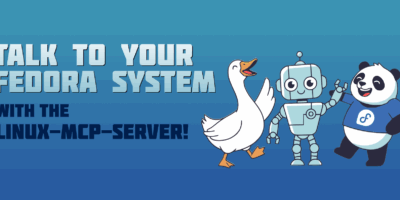Fedora is a big project, and it’s hard to keep up with everything. This series highlights interesting happenings in five different areas every week. It isn’t comprehensive news coverage — just quick summaries with links to each.
Get Fedora Stickers Worldwide
Earlier this month, Fedora began a new partnership with a common name among people who love picking up new Linux, FOSS, and software swag. Fedora and UnixStickers are proud to bring Fedora stickers to the lineup. There are a wide assortment of stickers you can choose from, with either the full Fedora logo and text, just the infinity logo, and case stickers to show to all your friends, family, and co-workers that your rig is powered by Fedora. This relationship is also mutually beneficial to both UnixStickers and Fedora, so your sticker purchases also help support the Fedora Project too.
And, unlike the existing Fedora section of Red Hat’s Cool Stuff Store, UnixStickers does global shipping with reasonable prices, so this isn’t limited to the United States. That store carries t-shirts, pint glasses, and other swag which we don’t yet have on UnixStickers, but we’re hoping to expand the lineup there too.
You can read the original announcement in an earlier article on Fedora Magazine.
Make sure you’ve actually downloaded genuine Fedora
The recent Linux Mint incident has a lot of people asking questions. Fedora contributor and infrastructure team member Kevin Fenzi has a blog post on downloading the Fedora distribution securely. We take this — and all security — very seriously, and are working on ways we can make this easier and even more safe.
Measuring conference impact and contributor retention
We spend quite a bit of energy, time, money, and other resources on Fedora’s presence at conferences. But, it’s unclear how much this actually matters — does it bring in new Fedora users? What about contributors? Well, over on the CommOps team, contributor
at the Fedora booth there, and then observing their activity after the conference. Accounts which start at the conference and then become ongoing, active contributors = measurable conference success. Read about this on the CommOps list, and stay tuned for more analysis of other conferences, and of course my favorite — pretty graphs.
Infrastructure Year in Review
Fedora Infrastructure is a busy and sometimes noisy area – and that’s a good thing. The Infrastructure team helps keep all of Fedora’s services, servers, and miscellaneous infrastructure running smoothly and as expected. They also help develop new software to run in Fedora. Take a look at apps.fedoraproject.org to see just some of the public-facing services they work on.
On the Fedora Community Blog, the Infrastructure team recently published their 2015 Year in Review. The post describes some of their highlights of 2015, such as migrating to Ansible and upgrading to RHEL 7, as well as some goals for 2016, like helping deploy Fedora Hubs.
Think you could help out with Fedora’s Infrastructure? Check out how to get involved with the Fedora Infrastructure team on the wiki.
Shrinking the minimal Fedora
Over the years, as disk space on servers, desktops, and laptops became less and less of a concern, the absolute minimal install of Fedora grew and grew. Suddenly, though, with cloud computing and containers, small is beautiful again. A small base reduces network traffic and deploy time, and perhaps more importantly, reduces effort and churn when a security vulnerability needs to be patched.
Right now, the base Fedora cloud and container images are bigger than ideal. But, for Fedora 24 and the future, it’s about to get a lot better. One of the biggest pieces of software, glibc (a fundamental building block of any Linux distribution in the traditional sense) now is split into langpacks, taking the size from 130MB down to “just a couple”. Another change to the coreutils package brings that (also fundamental) package down from 15MB to one. We’re also looking at more modular packaging for systemd (which is actually designed to be relatively modular at heart — it just hasn’t been packaged that way).
Fedora contributor Courtney Pacheco is working on other efforts to shrink the base, and with all this going on I’m confident that Fedora 24 and 25 will have the potential to offer a very nimble starting point, with, of course, our whole collection of packaged software to fit your needs on top of that.
Thanks again to Justin W. Flory and the CommOps team for help in putting this together!





